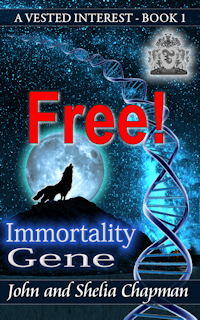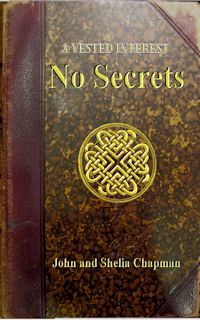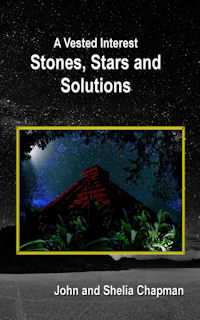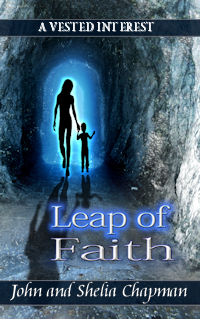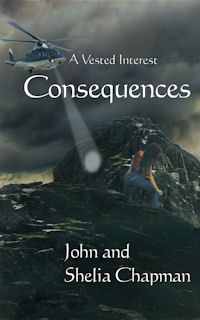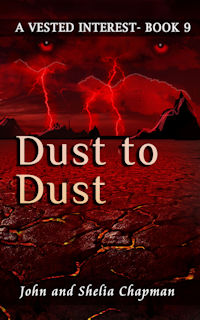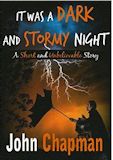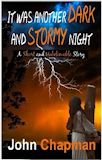The Science behind 'A Vested Interest' - DNA
If you look up a definition of DNA you'll probably find something like:
Deoxyribonucleic acid (DNA) is a nucleic acid that contains the genetic instructions used in the development and functioning of all known living organisms and some viruses.
The vast majority of people will think 'Yeah - Right' and some will probably think 'What's a nucleic acid?', 'Genetic instructions?' or 'What does it look like?'. This guide is for those people.
If you followed a link from social media here, I bet you thought I made a typo in spelling 'snip' as SNP. SNP is actually a DNA term - read on to find out more.
Some 'facts' you can take for granted are -
- The basic chemical which all living things are made from is DNA, an acronym of DeoxyriboNucleic Acid. This chemical is a highly complex and huge molecule arranged in the shape of a double helix (imagine two corkscrews intertwined)
- DNA was discovered in 1869.
- The double helix structure wasn't understood until 1953
- The approximate sequence of human DNA wasn't figured out until 2003 by the Human Genome Project
- By November 2008 the exact sequence of just four people had been established
- DNA is made up of smaller molecules called bases which are polymerised (joined together) in a VERY long chain. There are just four of these bases involved.
 This diagram shows a very short section of the helix straightened out. If you use a little imagination you can picture it as like a ladder. It's made up of carbon atoms - the black dots; Oxygen atoms - the 'O's; Nitrogen atoms - The 'N's; Phosphorous atoms - the 'P's; Hydrogen atoms - the 'H's. In some places, where there are three thin lines going to a carbon atom (black dot), a hydrogen atom is also attached but is not shown to make the diagram clearer. As you can see the 'rungs' of the ladder are made up of four different sections called Adenine, Thymine, Guanine and Cytosine. These are the 'bases' and often represented by the letters A, T, G and C. When these chemicals link together Adenine always links to Thymine and Guanine always links to Cytosine. A pair of these bases make a 'rung' on the ladder. This short section of DNA might be recorded as 'ACTG' because from the top left the sequence is Adenine, Cytosine, Thymine and Guanine.
This diagram shows a very short section of the helix straightened out. If you use a little imagination you can picture it as like a ladder. It's made up of carbon atoms - the black dots; Oxygen atoms - the 'O's; Nitrogen atoms - The 'N's; Phosphorous atoms - the 'P's; Hydrogen atoms - the 'H's. In some places, where there are three thin lines going to a carbon atom (black dot), a hydrogen atom is also attached but is not shown to make the diagram clearer. As you can see the 'rungs' of the ladder are made up of four different sections called Adenine, Thymine, Guanine and Cytosine. These are the 'bases' and often represented by the letters A, T, G and C. When these chemicals link together Adenine always links to Thymine and Guanine always links to Cytosine. A pair of these bases make a 'rung' on the ladder. This short section of DNA might be recorded as 'ACTG' because from the top left the sequence is Adenine, Cytosine, Thymine and Guanine.- to write down the entire DNA sequence of a human being in this ...ATGC... format would take about as much text as two hundred, 1000 page telephone directories.
- if the DNA of a human was magnified to the scale of the image shown here (one inch wide) then the dna strand would be long enough to travel to the Sun and back 60,000 times. It would take a beam of light almost a year to travel it's length. Like we said DNA is LONG!
- In human DNA there can be as many as 220 million 'rungs' in a DNA 'ladder'.
- Where a particular 'rung' on a DNA ladder is different between two individuals this is called a single-nucleotide polymorphism or SNP (pronounced 'snip')
- There are areas of DNA which don't seem to do anything useful (as far as we know). Changing them seems to have no effect. These areas are called junk DNA. Within these areas there are well known sections called markers which have been given code names. It is these areas which are tested in genealogical DNA testing.
- Other areas of DNA are crucial and a slight mistake in them can cause a devastating genetic disease.
- The order in which the rungs appear in the ladder is what makes us different from each other. In identical twins the order would be almost identical. 99.9% of our DNA is the same in all humans. We share 96% of our DNA with chimpanzees, 85% with mice and about 50% with a tree.
- Different living things also have different lengths of 'ladder'
- DNA is found tightly wound up in chromosomes. In humans there are 23 pairs of these. These are big enough to be seen with a powerful optical microscope. They were first noticed in 1848.
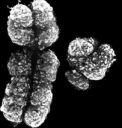 One of the pairs of chromosomes determines the sex of a child. Because of their shape these chromosomes are known as X and Y chromosomes. Females have an XX sex chromosome and males have a XY chromosome. The XY chromosome pair is shown in the picture on the left.
One of the pairs of chromosomes determines the sex of a child. Because of their shape these chromosomes are known as X and Y chromosomes. Females have an XX sex chromosome and males have a XY chromosome. The XY chromosome pair is shown in the picture on the left.
- A child gets his/her DNA from both parents The mother always provides an X chromosome the father either provides an X chromosome; in which case the child will be female; or a Y chromosome; in which case the child will be male.
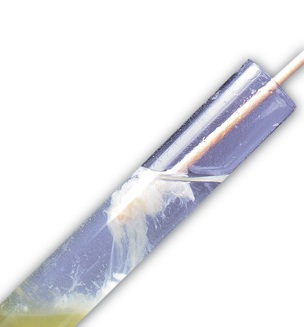 So what does DNA look like? Here's an extract of pure DNA wrapped around a stick:
So what does DNA look like? Here's an extract of pure DNA wrapped around a stick:
